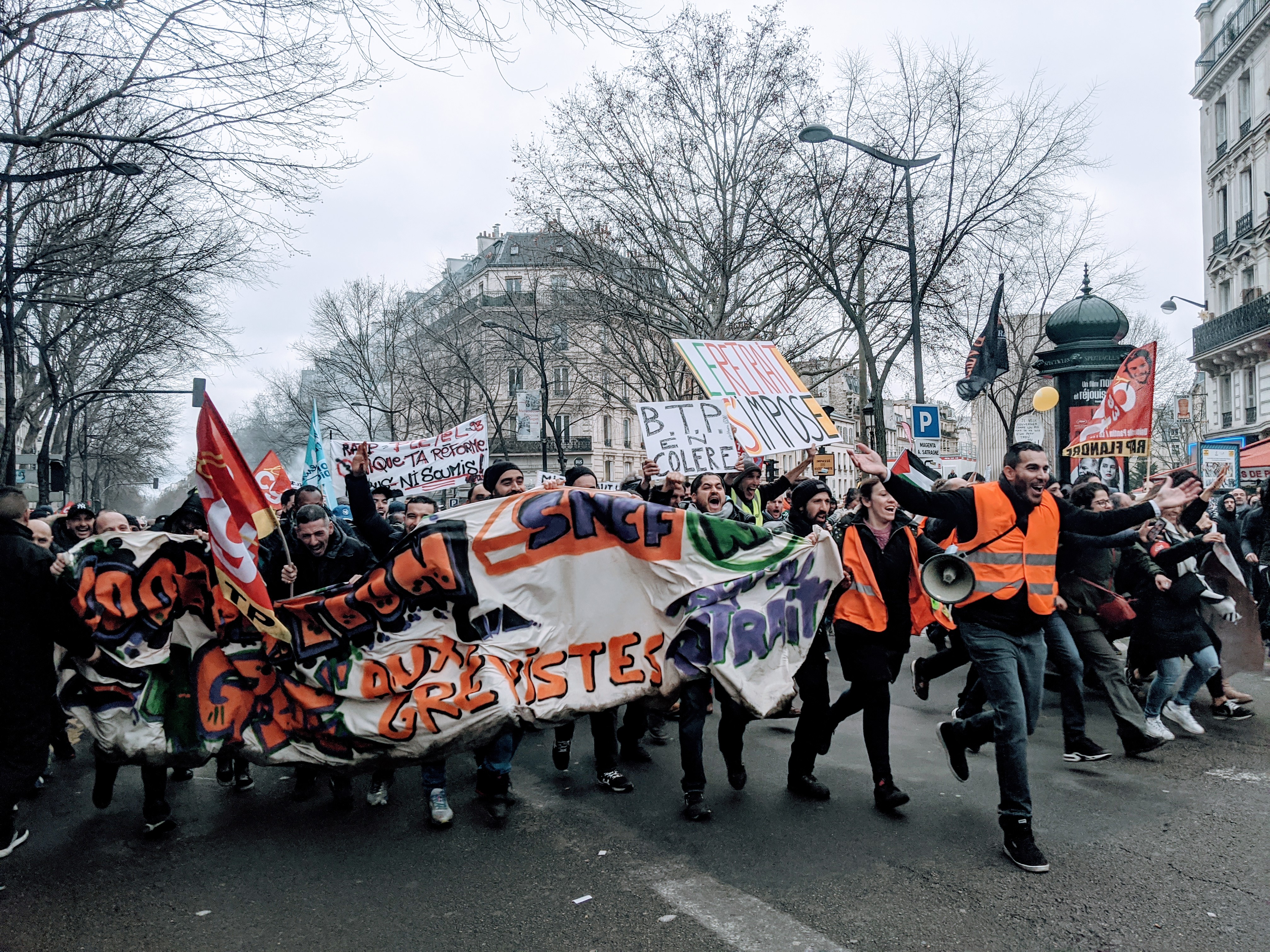France's general strike: 21st century class struggle

At lunchtime on 9 January, at the end of platform 36 of the Gare du Nord railway station in central-northern Paris, around 200 railway workers are gathered for a mass meeting. It is the day of the national protest intended to renew, and generalise, the strike that has gripped France since early December. Earlier in the morning, pre-dawn pickets had sprung up at bus and rail depots around Paris. Mass demonstrations in other cities had already been tear-gassed by police. 400 strikers had blockaded the Gravelines nuclear power station in the north.
But it is the Paris rail workers, some of whom are assembled on platform 36, that are the central protagonists of the national strike movement. Many have been on strike for a solid six weeks, enduring poverty over the Christmas period. Now, an inter-union general assembly – a meeting uniting rank-and-file railway workers from across France’s fractured union landscape as well as some not yet members of any union – is taking place prior to the mass rally that will soon begin forming up a couple of kilometres away in the Place de la Republique. This is one of hundreds of contingents that will combine into a mass rally of 300,000 or more striking workers. “We’re not going to win with just the people who join us on the demonstration today,” one of the workers told his assembled comrades. “I’m talking to all the workers in the movement, including those who might be at work tomorrow, to convince them to join us again tomorrow as well, to grow our numbers.”
For six weeks, the working class of France has been waging war against its government. Strikes have swept railway lines, refineries, schools, and power plants. Pickets have sprung up at transport depots. Enormous demonstrations have taken over the major cities and towns across the country. Paris’ demonstration on 9 January was kilometres long, with contingents from different industries and union federations, student contingents, lawyers, feminist blocs, a kaleidoscope of different campaign groups – each with their own chants, placards, slogans, and in some cases dance routines. But the movement’s heroes are these rail workers, who have maintained their strike consistently since 5 December last year, developing democratic rank-and-file organisations to decide their tactics and strategy.

The movement was detonated by the right-wing government’s attempt to “reform” – that is, trash – the country’s state pension system. But that proposed reform has become the catalyst for a test of strength between the French working class on the one hand, and on the other its bosses, represented by president Emmanuel Macron and prime minister Edouard Phillipe. If Macron wins, it will be a historical defeat for the French working class, and a triumph for Macron’s project of adapting neoliberal politics so that they can survive and thrive in the post-GFC world. If the French working class can win, they will not only have defeated a pension reform, they will have reasserted the leading role of the working class in the popular struggles that have broken out around the world over the last year.
For decades, French workers have resisted attempts to cut their pensions. But after a prolonged stagnation and membership decline in France’s key union federations, Macron and his fellow ruling-class warriors set out to finally win the great prize of pension reform and inflict a crushing defeat on one of the most influential trade union movements in Europe. Instead, he has ignited a movement that has proven the extraordinary power of working class action, its capacity to lead and unite struggles against oppression, its radically democratic nature, and its contemporary relevance in advanced Western economies. That movement, which is yet to achieve victory, has also illuminated the strategic, tactical, and political challenges faced by a working class movement on the offensive, and the questions that a revolutionary leadership must be able to answer in the course of struggle.
********
France’s pensions are often referred to as “generous”, but what this really means is that they have been defended effectively by a working class distinguished by its willingness to fight. In 1995 and 2010, pension reform proposals were met with national strikes. The 1995 strikes galvanised a generation of young workers. School and university students were involved as well, with major battles on some campuses. After three weeks, the proposal was abandoned. Strikes in 2010 were less powerful, and the right wing government managed to raise the retirement age by two years.
Since then, much has changed in French politics. The political crisis that has disrupted traditional parties around the world has been particularly pronounced in France. In the last presidential election, there was a surge in support for the far right National Front and the left reformist France Insoumise. The once powerful centre left Socialist Party collapsed, attracting only 6 percent of the vote. The political crisis meant that the young neoliberal Emmanuel Macron could sneak through the middle to win both the presidency and a parliamentary majority, despite having little social support. So, paradoxically, the collapse of the political centre resulted in an electoral triumph for a new centrist political force – a development celebrated by the international bourgeoisie.
The Confédération Générale du Travail (CGT) is France’s most important trade union federation. It has been dominated historically by the Stalinist Communist Party of France, and its bureaucracy still maintains the traditions of Stalinist trade unionism – occasional militant, anti-capitalist rhetoric, an implantation in key blue-collar workforces, a capacity to turn its members out for strikes that spook the bosses and a tendency to wind struggles up before they threaten the social order. But like so many trade union movements, even the once mighty CGT has been in decline, with its membership recently slipping below that of its rival, the conservative and more openly class collaborationist Confédération Française Démocratique du Travail (CFDT).
In 2018, a CGT-organised railway strike failed. Despite the heroic commitment of the rail workers, the federation adopted a bureaucratic strategy bound for defeat: a regular roster of two-days-on-strike, one-day-back-at-work, which allowed management to manoeuvre around the strike, and deadened the initiative of the striking workers. When the Yellow Vests burst onto the scene and brought thousands of new activists into the street to challenge Macron and fight his police, the CGT bureaucracy ignored calls for them to organise solidarity strikes and bring the popular, creative rebellion of the Yellow Vests in contact with the power of the workers’ movement.
Perhaps these two failures gave Macron the confidence to take on the CGT, and the unions more broadly, in a winner-takes-all battle over pensions. Maybe he judged that the CGT was so weak, it was ready to be knocked out with a final blow. The same crisis and disruption to French politics that brought Macron to power might lead overly enthusiastic neoliberals to think that workers’ organisations are ready to be suddenly consigned to the history books, like the Socialist Party of France seems to have been.
But there is another side to that crisis. The collapse of traditional politics has come alongside a revival of popular struggle, as the poor have taken to the streets themselves, willing to try solving their problems without the aid of politicians. France saw one of the first movements of the new wave of popular struggle when in late 2018, the Yellow Vest movement exploded without warning. Weeks of massive street protests throughout France’s towns and cities forced Macron to drop a proposed tax increase. The people of Algeria, a French-speaking former colony and homeland of many first, second, and third-generation migrants in the French working class, soon followed with a revolution that is still unfolding. Those movements – powerful, creative, spontaneous and victorious – undoubtedly made an impression on the rail workers whose union had spectacularly failed them in mid-2018. On 3 December, two days before this strike movement officially began, French daily Le Monde was warning that the union bureaucrats were faced with a “radicalisation at the base”, under pressure from rank-and-file activists and “workers influenced by the Yellow Vests”. The inter-union general assemblies were an important part of this, and were encouraging mass participation in the strike. Their slogan was “la grève aux grévistes”: “the strike to the strikers".
********
Many on the French left speak of the giletsjaunisation (“Yellow-Vest-ification”) of the French workers’ movement. Is this taking place?
The Yellow Vests were, in the main, disorganised, politically inexperienced, unaffiliated, leaderless, and spontaneous. The French strike movement is not. This is not a case of the disorganised workers surging to the forefront in a spontaneous rebellion. The strike is organised through the existing union structures, especially the CGT and its smaller leftist rival Sud, which collaborate in calling actions and issuing statements. Its key activists are highly organised and politically conscious, both at the “top” in the form of the entrenched union bureaucracy, and at the “bottom” in the rank-and-file militants who are leading the ongoing strikes. The workers’ general assemblies have been officially approved by the union bureaucracy.
But this strike, by all accounts, is different from what has come before. It is clear that the workers see the Yellow Vests as heroes and models, admired for their defiance, their originality, their bitter hatred of Macron and the police, and their fighting spirit. Organised workers have adopted chants invented by the Yellow Vests. “Macron makes war on us / and so do his police / but we remain determined / to blockade the entire country” are the lyrics of a song sung as the Yellow Vests took over regional towns and descended on Paris, and which was again heard during the big strike demonstration of 9 January. The signature Yellow Vest chant is simply “tout le monde déteste la police” (“everyone hates police”), a chant which has been taken up with gusto by the striking workers, used both to intimidate the police and as a friendly gesture to any Yellow Vests that drift through the demonstration.
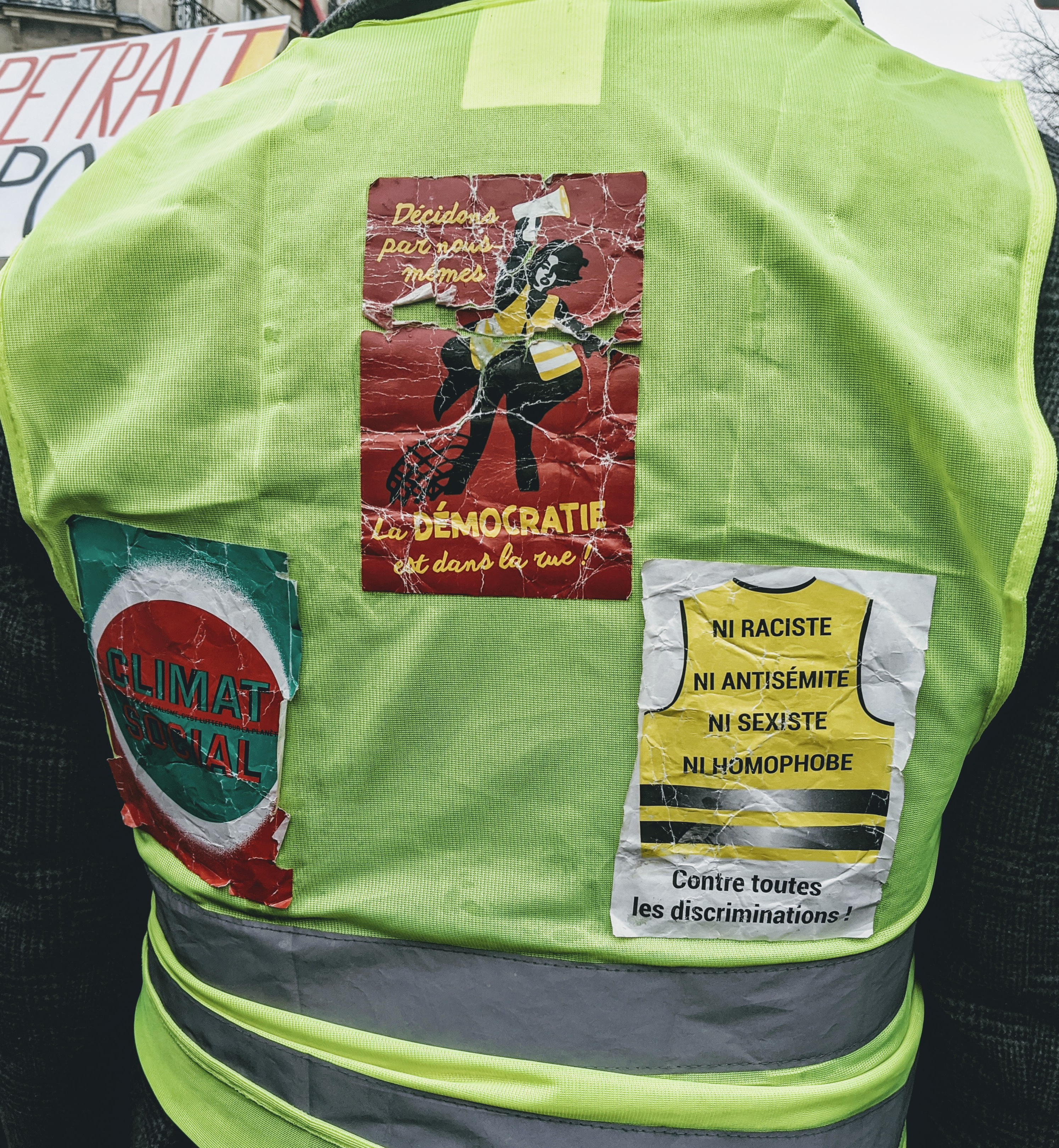
Scattered Yellow Vests attend the strike protests, with their vests still bearing the characteristic slogans that animated the movement – including the call for a citizen-initiative referendum, a proposed constitutional reform that would allow more direct votes to overrule the decisions of politicians. The Yellow Vests’ practice of writing elaborate manifesto-like declarations on their high-visibility vests has also been taken up by the striking workers, a practice which turns protesters into walking placards, honours the clothing that defines blue-collar workers, and shows respect for the thoughts and opinions of each participant. “Insurrection, where are you? Can you hear us?” read one.
Where the Yellow Vests’ example of creativity, boldness, and initiative-from-below encounters the structures of the capitalist workplace, it results in something more powerful than either the Yellow Vests or the bureaucratic approach to class struggle favoured by the CGT. The general assemblies – the mass meetings of striking workers that have flourished in this movement – turn each workplace into a political forum, a place where workers can initiate and decide actions, determine whether, and why, to extend their participation in the strike and combine their individual insights with their collective identity and their economic power.
The Yellow Vests emerged from outside the workers’ movement to provide a model of fighting spirit that puts the union bureaucracy to shame. The workers’ movement has now taken the lead in the struggle against Macron, adding an economic power and a capacity for democratic mass organisation that the Yellow Vests lacked. The public appear grateful for the leadership of the working class, with polls showing strong majority support for the strike, even though every day the Paris metro system alerts passengers that there are “major disruptions on all lines, because of a social movement”. Within the working class, a minority of workers – most especially the rail workers – stand out for their fortitude, initiative, and organisational strength. They are a true “vanguard”, a section of the working class that is at the forefront of a prolonged class battle.
The strike has been punctuated by big national demonstrations. These demonstrations bring hundreds of thousands of workers into one-day strike action with their comrades in the rail, ports, docks, and other industries who have been out for weeks. Mass demonstrations always show the potential collective power of the oppressed. When they take the form of a national strike, shutting down key industries and creating enormous processions that dominate whole cities, that potential becomes a reality. These are not protests to make a moral point, or to express support for a particular candidate or policy. They are demonstrations of collective power. When they honour workers who have been at the forefront of the movement, striking for weeks and vowing to carry on until they win, rallies move from being mere demonstrations of popular opinion to more like displays of military might. They show off the forces that can be, and are being, used in active class combat. But it’s a military parade with a festival atmosphere. Contingents of refinery workers bang out driving rhythms on metal oil drums slung around their necks, and rail workers run through a seemingly endless array of chants and songs while setting of flares and fireworks, celebrating their own energy and defiance.
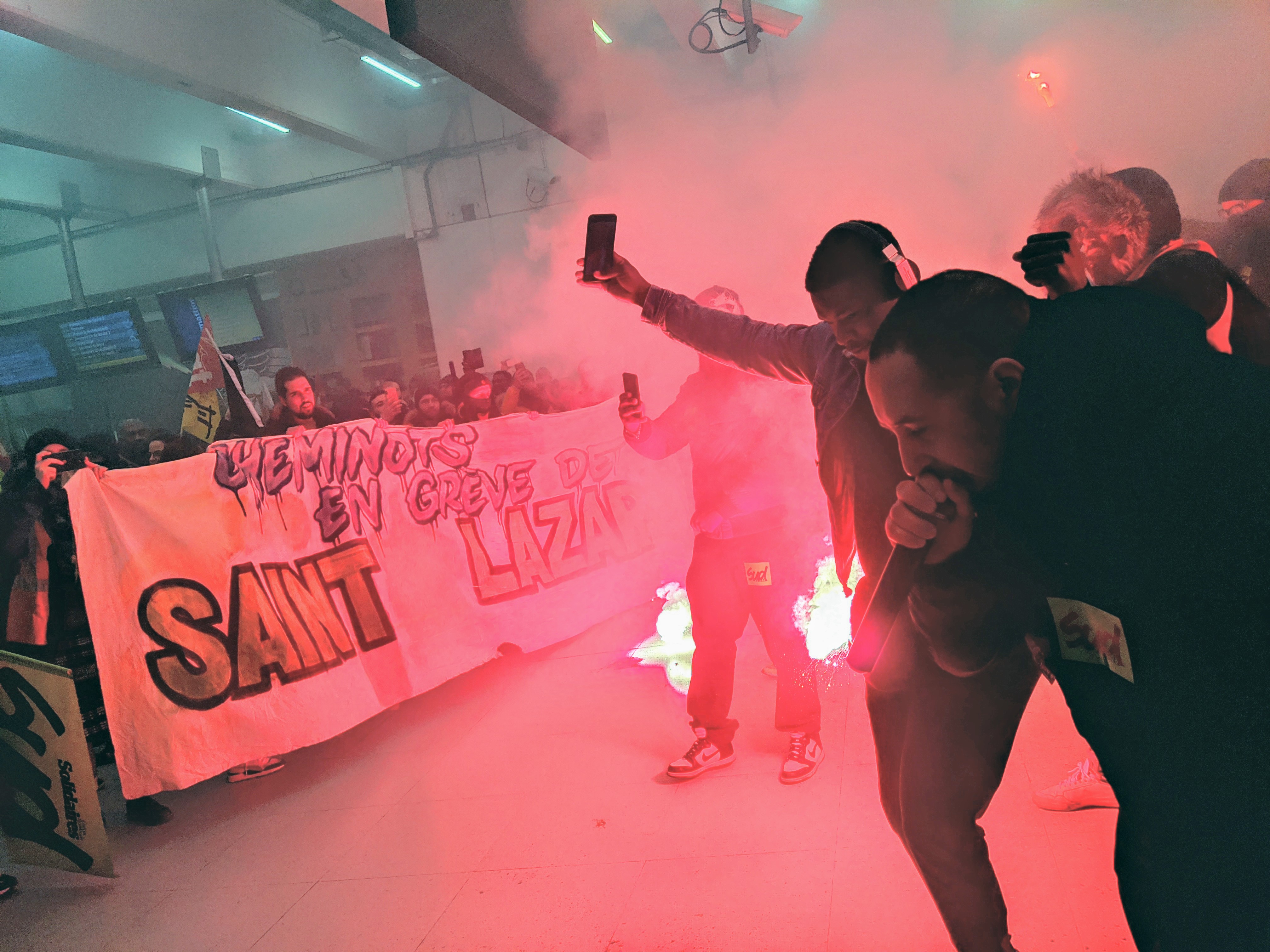
When workers strike against the ruling class, they display a power that can attract the loyalty of any oppressed person. Throughout Paris on 9 January, apartment balconies were slung with banners offering support to the striking workers. “Hold fast,” read one: “They’re nothing, you’re everything.” The rally was full of contingents representing different groups and professions that were not necessarily working class, or part of the workers movement, but nevertheless wanted to participate and show support for the leading and most militant workers. Lawyers, who have increasingly been drawn into the strike movement, came in their traditional black gowns. A large feminist bloc, with participants dressed as Rosie the Riveter, performed a song and dance routine to the 1987 French pop hit A caus’ des garçons, “Because of Boys”, with the lyrics changed to A cause de Macron, “Because of Macron”.
As the prolonged strike bites, it forces itself into the consciousness of every part of society, and makes everyone pick a side. I witnessed an example of this polarisation in the student world. University exams were scheduled to begin in the second week of January, but because the trains were so badly disrupted, most Paris universities cancelled theirs. The University of Nanterre didn’t. Its administrators advised students to sleep on the gymnasium floor if they were worried about getting in on time. Students could either turn against the striking workers for jeopardising their academic career, or turn against the university for scheduling exams during a strike. The student left intervened, with a group of student Trotskyists organising to arrive before dawn on the second day of exams and drag bins and temporary fences in front of the entrances to exam halls. To the crowd of around 300 students arriving for their exams, the leftists made speeches justifying the barricade, and distributed a leaflet:
“Today, thousands of workers, led by the rail workers, are entering the 34th day of their strike. At the time of this exemplary strike movement, Nanterre is the only university in Paris continuing exams... This isn't the time for exams, but for mobilisation, for the strike, for protests, and other actions... Today, everyone’s battling against pension reform, and a big part of the population are battling against Macron and his whole government... Come to a general assembly to discuss how to mobilise best to blockade the exams... No exams, let's join the movement!”
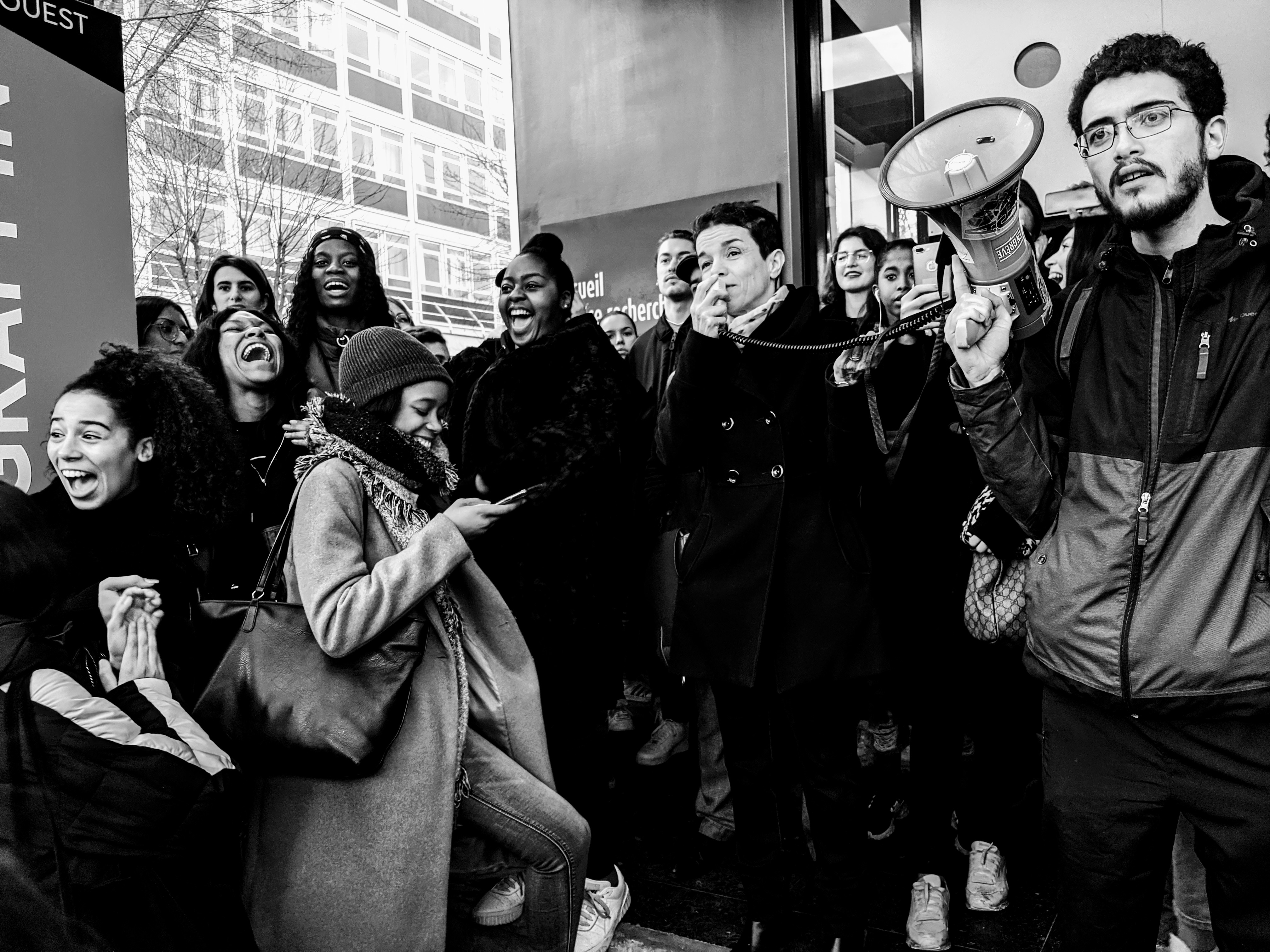
To my astonishment, their intervention was successful. On the other side of campus, right wing law students fought the protesters and dismantled the barricades. But at this blockade, hundreds of students, who had come in early in the morning for exams, decided on the spot to support the action. When a university administrator came out to plead for the barricades to be taken down, the students laughed and threw paper planes at her, chanting “Solidarity! Solidarity!” After a couple of hours, the students left the exam venue and went to the student general assembly, where they heard speeches from striking workers and voted to support an exam boycott. A new link of solidarity between students and workers had been forged, and hostility to university management had been deepened.
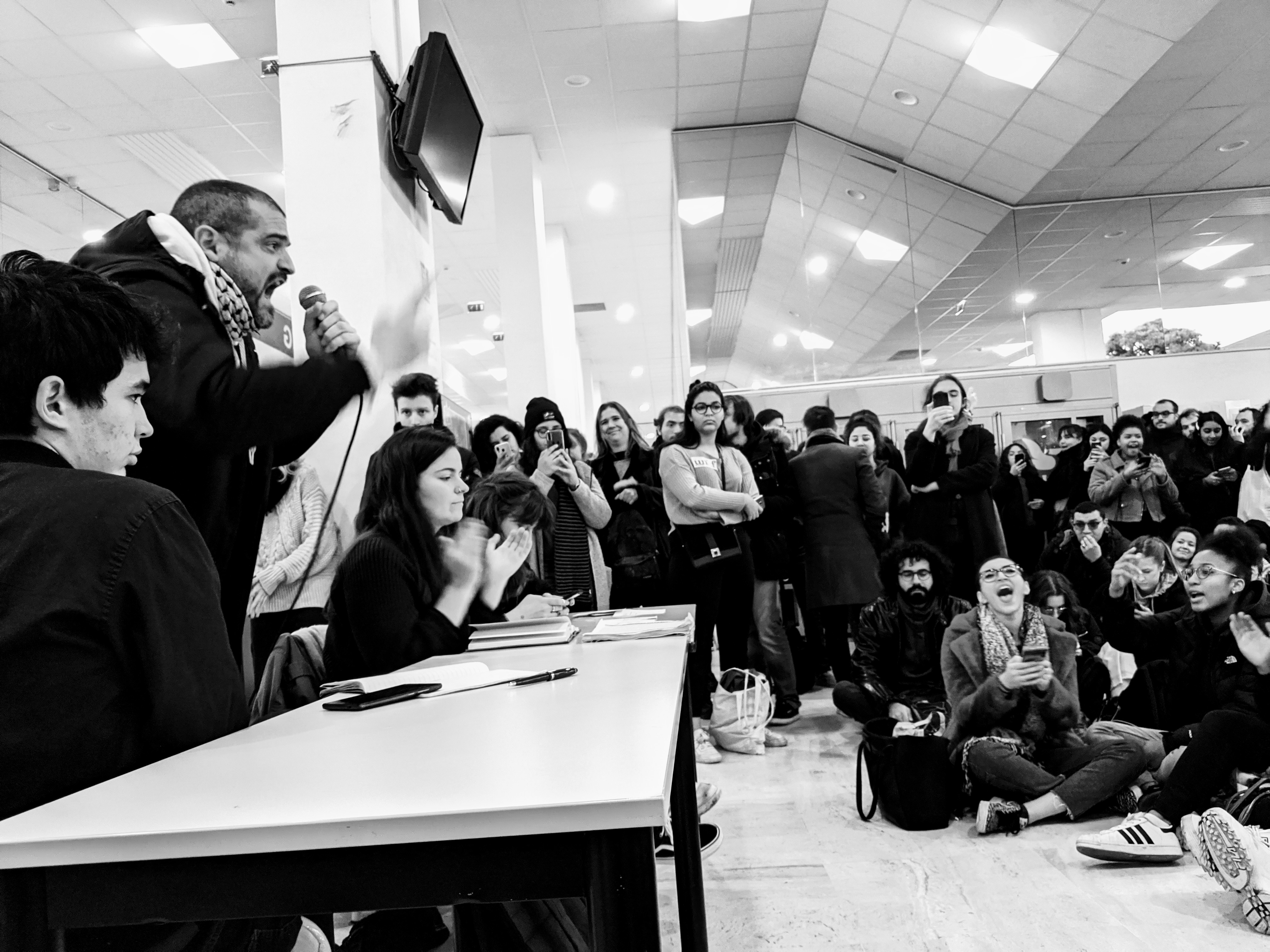
The 1995 strike in France summoned up a wave of protests and occupations on university campuses and high schools. Those movements have been less pronounced in the strike of 2019-2020. The experience at Nanterre gives at least a partial explanation. The leading figures in the event – both the initiators of the student blockade and the striking workers who came onto the campus – were of the far left, mostly Trotskyists. That is, they were people with a permanent perspective of intervening into social movements to build solidarity and self-organisation amongst the oppressed. Since 1995, the French far left has declined in number, partly thanks to its misadventures in electoral politics and its failed attempts to construct broad non-revolutionary parties. Although the movement has incredible potential, there are now thousands fewer revolutionaries in schools, campuses, movements, and workplaces to turn the strike’s social disruption into an explosion of social solidarity.
********
Behind the battle between the workers and Macron is another battle-in-waiting, between the union bureaucracy and its rank and file. The strike is coordinated by an inter-union committee representing five union federations, but its backbone is the ex-Stalinist CGT, with its history of selling out and winding up strikes. After the CGT’s failure in the 2018 rail strike and its refusal to form an alliance with the Yellow Vests, an increasing number of worker activists became conscious of the need for a democratic alternative leadership, based in the rank and file. The current movement has developed through the workers’ general assemblies, which are necessary to allow joint discussions amongst workers loyal to different union federations. But in the Paris rail at least, these assemblies have been the basis for the development of a truly impressive rank-and-file movement.
On the morning of the 9 January demonstration in the Gare du Nord station, hundreds of workers took part in a final meeting before the rally. After their vote to participate, they marched behind their beautiful hand-painted banner, bearing the rank-and-file slogan, “the strike to the strikers”. When they began to chant “Whoever doesn’t jump isn’t a striker”, the resulting mosh-pit drew in workers from the right-wing federation which hasn’t even supported the strike movement. Passing through different train stations on their way to the central rally, setting off flares and fireworks, chanting and dancing with incredible energy, they ultimately took their place at the head of the protest march –symbolically asserting the rank and file workers’ leadership, or desire for leadership at least, of the strike movement. That was a new step forward for the rank and-file movement. These rail workers are the most important and determined in the national strike movement, and they are the most conscious of the need to organise separately from the union bureaucracy. That’s important for the strike, as it helps strengthen and broaden participation, encourage initiative and defend it from attempts at sabotage from union bureaucrats. And, as is always the case with workers’ struggles, the most effective tactics are also those that develop radical, democratic and participatory forms of social organisation.
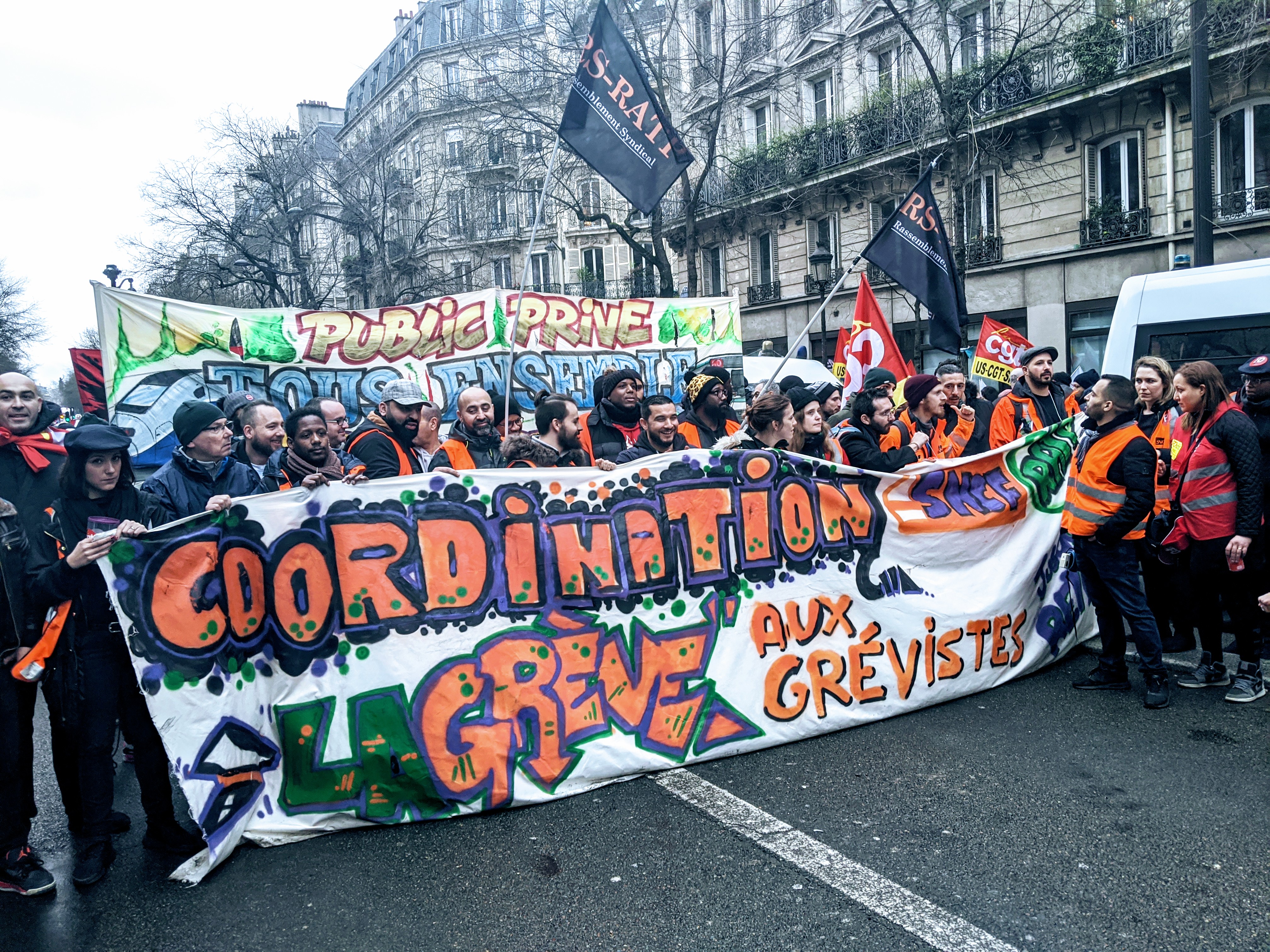
Revolutionaries have played a key role in initiating, deepening, and strengthening the self-organisation of the working class. The pitifully small revolutionary groups are significantly over-represented in the on-the-ground leadership of the workers’ movement. Throughout the workers’ general assembly and its participation in the six-hour-long rally, the most prominent leader was Anasse Kazib, a French-Moroccan Muslim Trotskyist rail worker who has become a very rare thing: a celebrity worker-militant. Kazib has played a vital role in developing workers’ self-organisation in the Paris rail in the lead-up to this strike movement.
********
The 9 January demonstration took place after Macron had tried to starve the strikers out over Christmas. Macron failed, the strikes remain popular, and the protests were enormous – the momentum was enough to spread into three days of action, culminating in more national rallies on the following Saturday. But the movement now has to go forward, or it will go backwards. The strike had been creating pressure on the right-wing unions to participate. Macron’s government has indicated token “concessions” transparently intended to ease that pressure while keeping the core of the attacks on pensions intact. “Generalise the strike” is the slogan of the left, in the unions and elsewhere. More sectors must come out to participate in ongoing strikes, not just on the days of the big mobilisations. Either the rail strikes will gradually dissipate, or the strike movement will spread to more sectors. That is the challenge the movement now faces.
The unions have tried to spur this on by calling for three days of mobilisations in mid-January: pickets, protests, new strikes, and whatever else can drive things forward. Ports and power plants have been shut down. Lawyers have occupied courthouses overnight; schools have been blockaded and turned over to host general assemblies of workers; striking workers have besieged postal depots, fought past cops, and welded the gates shut; far in the south, a contingent of Yellow Vests stood on the railway tracks in Hendaye to block trains. At the concluding rally on January 16, the rank-and-file railworkers marched in a joint contingent with the refinery workers. The inter-union strike committee has called another three-day national mobilisation beginning 22 January.
In the long run, perhaps the CGT bureaucracy will be content with another defeat, as long as the movement restores its reputation somewhat with militants and helps poach members from rival federations. But for the rank-and-file workers – who have fought under the slogans “we’ll go on until the bill is withdrawn” and “the strike to the strikers”, who have voted in their assemblies to renew the strike day after day, and who will have to vote to wind it up when that day comes – much more is at stake. Win or lose, this strike is one moment in a longer process of rebuilding and further radicalising the working class movement.
To those who say the working class has changed beyond recognition since Marx’s day: look at France. There’s no working class more modern. Just as they did in May of 1968, the French workers have disproven in one stroke the idea that socialists should turn away from the working class: there’s no force in society more powerful and more democratic in its methods of combat. But the workers’ movement must be infused by the rebellious, street-fighting spirit of a grassroots social movement; and by the intervention of revolutionaries on the ground, whose anti-capitalist worldview and belief in the capacity of the working class means they play an irreplaceable role in generalising and deepening struggles. France’s workers give us all a glimpse of the power and radicalism of working class movements. We should hope that more and more of the global struggles against neoliberalism, authoritarianism, and climate change will be led by such heroes.
